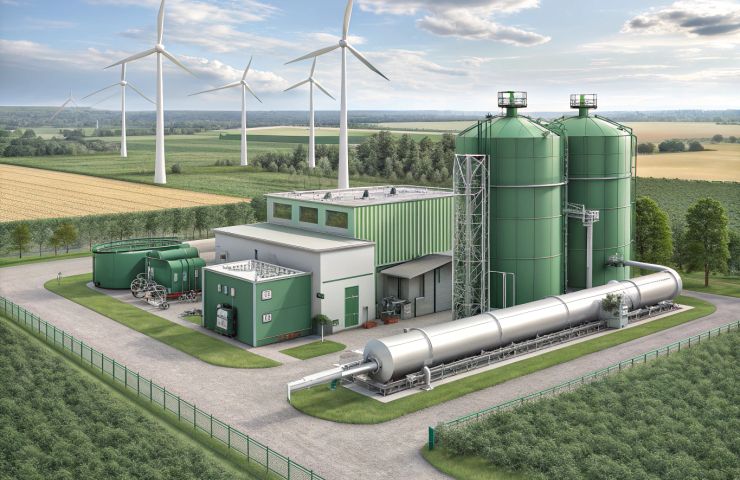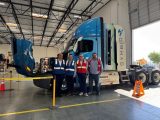
Green Hydrogen Production Set to Scale at Bad Lauchstädt Energy Park
October 16, 2025Could Germany’s industrial heartland actually become a green hydrogen powerhouse? At the Bad Lauchstädt Energy Park in Saxony-Anhalt, we’re about to find out. Spearheaded by Ontras (part of the VNG Group) and backed by a €210 million investment, the project brings together energy heavyweights Uniper, VNG, project developer Terrawatt and electrolyzer specialist Sunfire. It’s also a direct response to Germany’s scramble for energy sovereignty after phasing out Russian gas. When it ramps up at the end of 2025, its 30 MW pressurized alkaline electrolyzer will use wind power to churn out as much as 4,000 tonnes of green hydrogen a year—revolutionizing hydrogen production in the region and cementing its place as one of Europe’s largest integrated green hydrogen demonstrations.
At its core sits Sunfire’s pressurized alkaline electrolyzer technology. In a caustic environment, an electric current splits ultra-purified water into hydrogen at the cathode and oxygen at the anode. An on-site purification unit treats the feed water to strict standards, warding off membrane fouling and keeping uptime high. Pressurizing the system to 30 bar ramps up output density, slashes compression costs and streamlines storage. With 48 stacks totaling 30 MW, it can run flat out whenever the adjacent 90 MW wind farm is blowing, turning variable renewables into a steady stream of green hydrogen through efficient electrolysis.
A Pipeline Reborn
Rather than dig up new trenches, the consortium certified 25 km of former natural gas pipeline for hydrogen infrastructure. After material tests at up to 100 bar and essential safety upgrades, it’ll transport roughly 2,700 tonnes of green hydrogen a year to TotalEnergies’ Leuna refinery. There, it replaces a chunk of fossil‐derived hydrogen in refining processes—slashing CO₂ emissions by about 25,000 tonnes annually and boosting regional energy security.
Shifting a Region’s Energy DNA
Saxony-Anhalt, home to 2.14 million people and boasting a GDP per capita around $36,220, cut its teeth on coal mines and chemical plants. Since reunification, it’s wrestled with structural shifts and industrial decline. The Bad Lauchstädt Energy Park sits smack in the Central German Chemical Triangle—a tangle of old pipelines, power lines and processing units. Now, those arteries will pulse with green hydrogen instead of brown coal, symbolizing a genuine pivot toward industrial decarbonization.
Behind the scenes, EU and German IPCEI (Important Projects of Common European Interest) funding helped seal the deal. In 2023, Ontras locked in the €210 million financing package, tying national decarbonization targets to Brussels’ broader hydrogen strategy. This co‐investment model makes high‐capex ventures like large-scale electrolyzers feasible and lays the groundwork for a pan‐European hydrogen infrastructure.
Terrawatt put its wind and solar portfolio manager on the case, syncing farm output with the electrolyzer’s load profile. By fine-tuning generation forecasts, tapping smart‐grid hooks and deploying short‐term battery buffers, they’re aiming for an electrolyzer capacity factor north of 80%—a huge leap over stand‐alone green hydrogen plants.
On the demand side, TotalEnergies will offtake up to 2,700 tonnes of green hydrogen annually from 2026 onwards. Slipping it into Leuna’s hydrocrackers and desulphurization units could cut CO₂ by roughly 25,000 tonnes each year. It’s a clear demonstration of how heavy industry can absorb green hydrogen without ripping out its core processes.
In phase two, the partners will explore underground hydrogen storage in salt caverns. These hollowed-out formations could buffer seasonal swings in wind output, feed refuelling hubs or power gas‐fired plants in emergencies. If it all pans out, the caverns will act like a regional energy bank—smoothing price swings and boosting grid resilience.
Beyond megatonnes of green hydrogen, the project brings local jobs in engineering, construction, pipeline conversion and operations. It also gives regulators a live testbed for hydrogen purity, pressure standards and cross‐border trade rules. Nearby chemical giants and OEMs are watching closely—many will need similar solutions for decarbonizing heat, feedstocks and power.
Of course, hurdles remain. Green hydrogen still carries a price premium over its grey cousin. Electrolyzer capex is steep, and grid bottlenecks can throttle output. The sector needs clear carbon accounting and long‐term offtake agreements to secure financing. Yet, when you stack those costs against the social and environmental toll of fossil fuels, the total cost of ownership for green hydrogen is looking more competitive every day.
For the partners, Bad Lauchstädt is more than a one‐off: it’s a blueprint. Uniper is eyeing follow‐up plants across its German and Nordic footprint. VNG and Ontras have mapped nearly 4,000 km of pipelines for hydrogen‐ready conversion. Sunfire plans to scale its pressurized alkaline stacks to 100 MW, and Terrawatt sees co‐located wind-electrolyzer sites as its next growth engine.
Looking Ahead
When the plant hits full steam by late 2025, it’ll be a genuine watershed for Europe’s hydrogen production and industrial decarbonization playbook. From a former coal belt to cutting-edge electrolysis, Saxony-Anhalt’s Bad Lauchstädt Energy Park proves that bold policy, advanced tech and industry muscle can rewrite the rules. If everything clicks, this project won’t just swap grey hydrogen for green—it’ll flip a region’s energy script for good.



 With over 15 years of reporting hydrogen news, we are your premier source for the latest updates and insights in hydrogen and renewable energy.
With over 15 years of reporting hydrogen news, we are your premier source for the latest updates and insights in hydrogen and renewable energy.